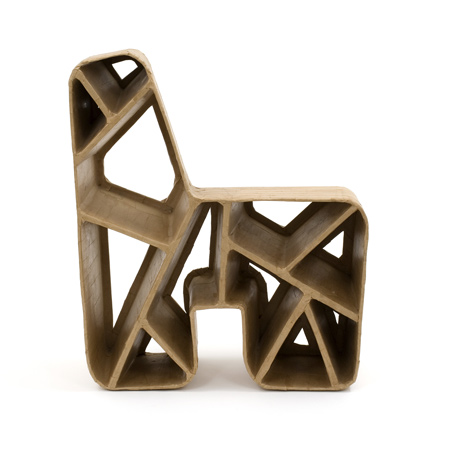Here's a selection of projects and products by Brazilian designers Fernando and Humberto Campana that are currently on show at the Vitra Design Museum in Weil am Rhein, Germany, as part of a retrospective of the brothers' work.
The work is grouped into nine themes: Fragments, Hybrids, Objets Trouvés, Knots, Sticks, Organics, Flexed Planes, Paper Pieces and Clusters. Top image: Children chair, untitled, 2005. Above image: Screen, untitled, 2006.
More information and exhibition photographs in our previous story. Above: Fruit bowl, Nazareth, bronze, 2008. For Bernardaud © Bernardaud, Paris.
All photographs by Fernando Laszlo and © Estudio Campana unless otherwise stated.
Here are some of the objects on show, with explanations about each group from the Vitra Design Museum. Above: Figure for stage design Peter and Wolf, Duck, 2008.
--
Fragments
“Fragments” shows objects which the Campanas constructed through an assembly of similar parts: a new version of their famous “Favela” armchair from 1991 belongs to this group as well as an abstract terracotta sculpture of shattered forms, which Humberto realized in 1982 – several years before the brothers began working together.
In fact, the majority of the exhibition’s groups consist of both early and recent works and thus demonstrate the continuous development of their interests. Above: Waste basket, untitled, 2008.
Hybrids
Following a number of experiments in the mid-1990s, the Campanas have returned in recent years to the combination of contradictory materials.
The exhibition’s largest object, a sculptural seating of wicker and crystals, realized by the Campana brothers on the occasion of their appointment as Design Miami’s “Designers of the Year” in 2008, will be presented in an installation with other “Hybrids” such as the “Animado” rug of cowhide and synthetic turf from 1997. Above: Seating landscape, Diamantina III, 2008.
Above: Una Famiglia, 2006.
Objets Trouvés
Many of the Campanas’ artistic techniques recall methods utilised by surrealist artists in their painting, graphics, sculpture or film.
They link the influence of Surrealism on 20th South American art with the widespread practice of recycling prefabricated objects in their native Brazil and reinterpret these as materials for their own designs. Above: Tatoo, 1993, prototype for Fontana Arte.
Above: Jenette, 2005, for Edra © Edra.
Above: Screen, Cerca II, 1994.
Above: Vermelha, 1993, for Edra © Edra.
Knots / Sticks
Numerous of the Campanas’ furniture and accessories are created solely from linear structures.
Seemingly they depict patterns of the natural and urban jungle as the crucial coordinates of Brazilian life and a permanent inspirational source of Fernando and Humberto Campana, “following amorphous ideas” Fernando Campana². Above: Yellow Corallo, 2004.
The exhibition shows these sources in slideshows with many examples of their own photographs as well as in two short films shot by the designers themselves: an annotated tour of the center of Sao Paulo and a view of their tree house outside their home town of Brotas. Above: Fios, 1990.
Above: Vase, Bola, 2001.
Above: Relief, untitled, 2005 © Collection Alexander von Vegesack. Photo by Andreas Sütterlin.
Above: Mirror, untitled, 2008.
Above: Screen, Escultura, 1993.
Organics
The fascination nature exerts on Fernando and Humberto Campana is especially evident in numerous pieces of furniture and accessories that take the form of living creatures: in two fruit bowls from 1990, for example, in Edra’s sofa “Kaiman Jacaré”, in their “Drosera” wall pockets for the Vitra Edition or their “Mandacarú” toys.
Here as well, the subject will be illustrated by a slide show of some of their excursions. Above: Wall pockets, Drosera Copper & Velvet, 2007, for Vitra © Vitra.
Above: Aster Papposus, 2005, model for Edra.
Above: Kaiman Jacaré, 2006, for Edra © Edra.
Above: Mandacarú Formiga, 2006, prototype for Alessi.
Flexed Planes
The works from the second half of the 1990s seem to hold an exceptional position within their oeuvre.
All of a sudden we come across functional objects in sleek geometric forms made of industrial materials: the “Inflavel” side table produced by MoMA in New York for a number of years, the “Labirinto” shelf or the “Cone” armchair, both from 1997, are the most well known examples. Above: Side table, Inflavel, 1995, for MoMA, New York.
At second sight, however, we recognize that these objects too owe their inspiration to a genuine Brazilian motif: the audacious Modernism of an Oscar Niemeyer or Roberto Burle Marx, which are already reflected in Humberto Campana’s sculptures of the early 1980s. Above: Two-seater, Gangorra, 1997.
Above: Humberto Campana, sculpture, untitled, 1982.
Paper Pieces
The Campanas work almost exclusively with inexpensive everyday materials and discovered the versatility of corrugated cardboard early on.
Following a series of Vitra Design Museum’s workshops in Boisbuchet and parallel to the preparation of this exhibition, they are working with Vitra Design Museum on the development of several industrially produced utensils made of paper that the exhibition will present for the first time, along with a documentation of the process of design and production. Above: Papel sofa, 1993.
Above: Fruit bowl, untitled, 2008, prototype.
Clusters
The earliest article of daily use in the exhibition is a mirror – one of many that Humberto Campana designed in the early 1980s, excessively decorated with hundreds of seashells he had collected himself at the beach.
This exuberant sensualism too is a motif which the Campanas’ work repeats in the most diverse of forms. Above: Harumaki, 2004.
In their limited series of “Multidao” or “Banquete” armchairs, for example, Vitra Design Museum which have fetched top auction prices in recent years, the Campanas succeeded in using this impulse for their invention of new materials – another example of the recycling that has a constant presence in the streets of Sao Paulo. Above: Stool, Vitória Régia, 2002.
Above: Chair, Banquete, 2002.
Above: Chair, Sushi, 2002, for Edra © Edra.
More about the Campana Brothers on Dezeen:
.

